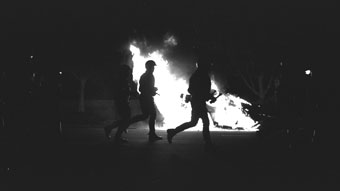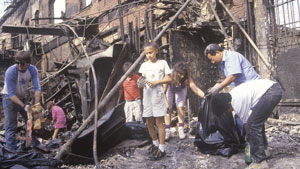Riots in the City of Angels
April 29 to May 3, 1992: Racial tensions explode in Los Angeles
Long before smart phones could capture footage for the world to see on Facebook, the grainy video of 25-year-old Rodney King’s brutal beating at the hands of Los Angeles police officers brought to prominence the issue of racial profiling and excessive force. The four officers charged—Theodore Briseno, Stacey Koon, Laurence Powell, and Timothy Wind—were white. King was black. Long-simmering racial tensions throughout Los Angeles suddenly blew up.
King, a paroled felon, had been driving drunk but would not pull over when a Los Angeles patrol car signaled him to do so. After leading police on a high-speed chase, he was arrested and then severely beaten. A nearby resident with a handheld camera captured amateur footage of just a portion of the incident, which left King with a fractured skull, broken bones, and internal injuries.

The officers were subsequently put on trial in a high-profile case that drew national media attention. When the men were acquitted on April 29, 1992, violent protestors almost immediately took to the streets of Los Angeles, looting, igniting fires, and creating a lawless melee that would rank among the most destructive incidents of civil unrest in American history. The exact number of riot-related deaths is open to question, but most news organizations put the total at more than 60. Thousands were injured.
Within a couple of days, it was clear the mayor and governor couldn’t quell the unrest, even with National Guard troops and curfews in place. President George H.W. Bush felt he had to intervene. He sent in several thousand federal troops to restore order, a decision for which he was widely criticized. He also took heat for waiting five days to visit, especially from the Independent populist Ross Perot, who was the front-runner in the upcoming presidential election. By May 4, the violence had subsided enough that the curfew could be lifted.

Here, top Bush administration officials recall behind-the-scenes details that led to the high-pressure decision to send the U.S. military into one of the country’s biggest cities.
The President wanted to know what the violence was about.... I told him the names of the gangs that were involved, that the violence was largely street gang activity, big-time gang, not like street gangs in the 1950s—Crips-type gangs.
William P. Barr
Attorney general
The state verdict came down on the cops. I was out in a press conference within a few minutes of it…. I went down to the press room and said, “There’s still a pending Federal investigation. This isn’t the end of the process. The Federal government will still continue to review this, blah, blah, blah. But we’re not going to tolerate any of this stuff out in the streets.”
Then [President Bush] called and wanted to know what we were up to and make sure we got a statement out. I said we’d just gotten a statement out. Then he said he wanted me to come by. I guess actually, later, as things got worse in California, he said he wanted me to come by the next morning at six or some ungodly hour. Overnight I had prepared this plan to use 2,000 or more Federal officers to supplement what was out there, basically to enforce the law out there. A lot of people think that the Department of Justice can just click its fingers and get a lot of resources, but the fact of the matter is it’s very difficult. We had only 150 marshals available as part of their special operations group. We put together an amazing polyglot organization of FBI, SWAT [Special Weapons and Tactics] teams, U.S. marshal SWAT teams, Border Patrol special operations group, a prison special operations group, and things like that. Even the Park Police put in their SWAT team.
We scraped together 2,000 people and told them to stand by at different airports and rally early that morning, because I figured the President might want something done. I showed up at the meeting. I had to go with [FBI Director William] Sessions.
The President wanted to know what the violence was about, and I told him that there were a lot of street gangs involved and this was primarily centered on street gang activity. I told him the names of the gangs that were involved, that the violence was largely street gang activity, big-time gang, not like street gangs in the 1950s—Crips-type gangs.
I explained that the L.A. police force is a very small police force—it’s highly mobile, but it’s very small. I said, “The National Guard is all screwed up, and they’re having trouble getting the National Guard there. We have two other choices. You can get as many civil guys out there as you can, and I have 2,000 who can move, but I would need air support from—” [Chairman of the Joint Chiefs of Staff Colin] Powell was sitting there. I said, “I need Colin’s help in getting them out there, but I could get you 2,000 people out there by three or four in the afternoon, assuming the military transports were available.”
I said, “The only other alternative would be regular Army.” We had just gone through an exercise two years earlier in St. Croix, so I was very familiar with how to use regular Army in a domestic situation. I understood all the code sections and what you had to do…. Basically the President has to issue a proclamation telling people to cease and desist and go to their homes. It’s sort of an antiquated statute. And then if they don’t cease and desist, you’re allowed to use regular Army.
…I said we can get everything ready to use Federal troops, but that was really the only other alternative. And Colin Powell said what troops were available, what bases, and so forth.
So he said, “Go ahead. Let’s launch those civilian guys. Let’s not try to resort to regular military right now.” I said, “Okay, who should I have [Deputy Attorney General] George Terwilliger talk to?” Powell gave me a name. And in an hour, they had transports starting off on the East Coast flying across the country, landing at Birmingham, Alabama, picking up the FBI agents there, landing in the next city, basically hopscotching across the country. Then they had Air Force buses waiting at the Air Base busing these guys in. So we did get everybody out there at the time I said.
I was hanging around the Oval Office at that point, and the president was on the phone to the governor. He was on the phone to the mayor, getting reports, asking, “Where’s the National Guard? When can you get the National Guard up there?” Very much engaged.
While I was there, he probably talked three or four times to the governor and one of the members of the Cabinet who was out there in California at the time. He talked to him. He was very engaged. He talked to some civil rights leaders who were calling in, and he was very much in command. Then he made the decision toward the end of the day that more power would be needed, and so we implemented the plan of using Federal forces. That was an interesting episode.
Q: Did he go out there?
Barr: No, but he went later.
…
Q: Was President Bush shocked by this dramatic event in Los Angeles? Did it have an effect on him? Did he see it as an indicator of something wrong that had to be fixed in America?
Barr: I can’t tell the extent to which he was shocked. He seemed surprised and wondered what was going on, what was this all about, and why the violence, that ugly violence. He asked me. Some people would probably disagree with what I told him, but I did lay a lot of it on gang activity.
Q: And you had a program to try and deal with that kind of thing.
Barr: Yes.
Q: But that didn’t galvanize.
Barr: Well, no one stopped me. We did make a lot of progress against gangs. But he wasn’t as comfortable in that policy area, I guess. My basic take was that this was not civil unrest or the product of some festering injustice. This was gang activity, basically opportunistic. I don’t know why he wasn’t more interested in these issues.
[President Bush] turns to Brent and he says, ‘Brent...how do I federalize the National Guard?’ Brent says, ‘I’m not sure I know either, Mr. President. I probably need to call Colin [Powell].’ I can’t believe this. So he gets Colin Powell on the phone and he’s going ‘Uh-huh, uh-huh, okay.’ Colin says, ‘All you’ve got to do is say it.’
David F. Demarest, Jr.
Assistant to the president and White House communications director
The L.A. riots took place. I got called into the Oval Office I think on the second or third day of the riots, and when I came in that morning [Chief of Staff Samuel] Skinner told me the President wanted to see me because he wanted to go on TV that night…. I listened to him and I heard what he wanted to say, and I decided I’d write this because it was going to be delivered that very night. I knew it was going to be controversial and I felt that to assign it to a writer was just going to be more complicated…. So I wrote it. I wrote what the President wanted me to write, a pretty tough speech.
He finishes the rehearsal. We go into the Cabinet room. There are four of us in there. It’s me and [National Security Advisor Brent] Scowcroft and Skinner and the President, five of us, counting the makeup lady. She’s got a smock on the President and he’s getting powdered and stuff. It’s about twenty to eight, a quarter to eight. His eyes are closed and he says, “Dave, the Governor [Pete Wilson] asked me if I would federalize the National Guard and I told him I would. Does that need to be in the speech?” [laughter]
I almost laugh—the whole speech is hortatory except for one news item, which is, I’m federalizing the National Guard. So I said, Mr. President, I think that’s kind of the news of the speech. He turns to Brent and he says, “Brent, I’m not sure how the mechanics of this works. How do I federalize the National Guard?” Brent says, “I’m not sure I know either, Mr. President. I probably need to call Colin [Powell].” I can’t believe this. So he gets Colin Powell on the phone and he’s going “Uh-huh, uh-huh, okay.” Colin says, “All you’ve got to do is say it.”